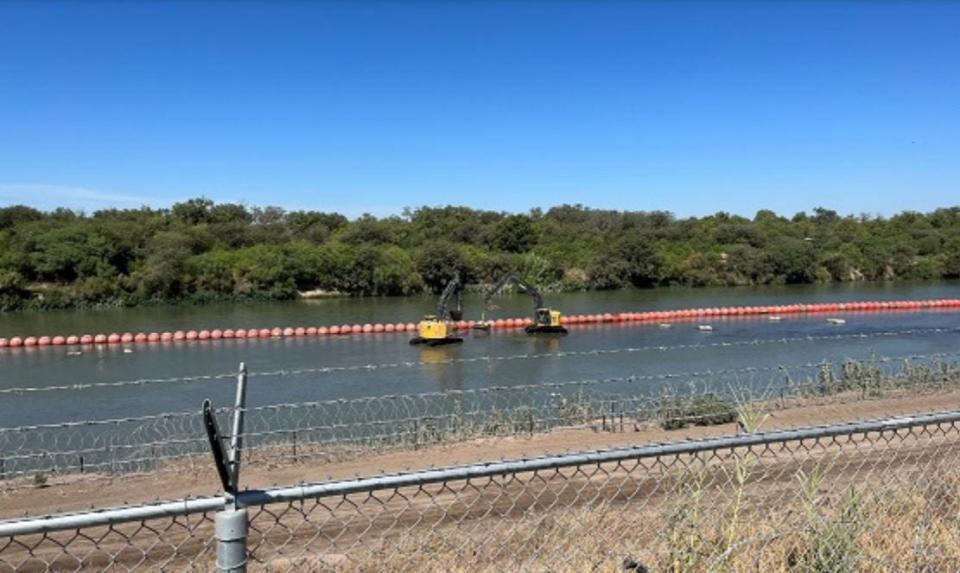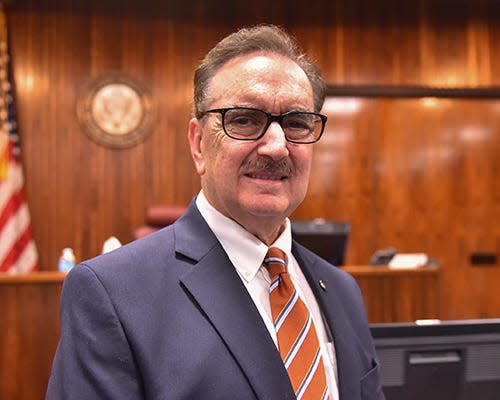Texas moves buoys to US side of Rio Grande ahead of Tuesday's court action
- Oops!Something went wrong.Please try again later.
- Oops!Something went wrong.Please try again later.
AUSTIN — Ahead of Tuesday's hearing in federal court over whether the chain of buoys installed in the Rio Grande at Gov. Greg Abbott's order must be removed, a work crew was documented relocating the barriers from the Mexican side of the river into U.S. waters.
The action by the crew, using heavy equipment in the section of the Rio Grande near Eagle Pass on Thursday, was the subject of a new filing by the U.S. Justice Department in the Western District of Texas. The filing is part of the federal government's effort to force the state to remove buoys that are intended to discourage unlawful border crossings.
The filing said the work is another example of "Texas’ ongoing and flagrant violations" of the Rivers and Harbors Act, which states that adding structures to navigable waterways requires approval by the U.S. Army Corp of Engineers. Abbott did not seek permission when he signed off on the buoys' installation in July.

Abbott on Monday acknowledged that the state had shifted the location of the devices, suggesting that they had "drifted toward the Mexico side" of the river after first being installed more than a month ago.
"Out of an abundance of caution, Texas went back and moved the buoys into a location where it is clear that they are on the United States side, not on the Mexico side," he said at a news conference.
Tuesday's hearing at the federal courthouse in Austin will be the first public faceoff between lawyers from the Justice Department and the Texas Attorney General's Office, plus private counsel, in the ongoing dispute between Abbott and the Biden administration over how to best address unlawful immigration into Texas.
Here is a look at the issues involved in the litigation and some of the key players in the controversy that dates to President Joe Biden's inauguration in January 2021:
Will Tuesday's hearing decide the case?
No. At issue is whether the 1,000-foot chain of buoys about two-and-a-half miles from Eagle Pass' international bridge can remain in place while the litigation proceeds.
Texas insists that the barriers are within the law because they help protect the state from an "invasion" of undocumented migrants and drug traffickers.
The Justice Department has said no such invasion is taking place and defines the term as an armed conflict against outside forces.
What is the Rivers and Harbors Act?
It's a law passed in 1899 that says that the "creation of any obstruction not affirmatively authorized by Congress, to the navigable capacity of any of the waters of the United States is hereby prohibited." The law designates the Corp of Engineers as the enforcement agency.
More: Abbott is wrong to define unlawful immigration as an 'invasion' of Texas, feds say
The state of Texas contends that the relevant section of the law does not apply in this matter. The act specifically mentions several structures that may not be constructed, including a wharf, a pier, a bulkhead or a jetty. The state contends that buoys fall into none of those categories.
However, the law also include the open-ended phrase "other structures."
Senior U.S. Judge David Alan Ezra
He will preside over the case. Originally appointed to the federal bench in Hawaii in 1988 by President Ronald Reagan, Ezra accepted senior status and a transfer to Texas in 2012. He earned his law degree from San Antonio's St. Mary's University and is "visiting jurist in residence" at the law school.

More: From Hawaii to Texas: Meet the judge who will preside over US v. Abbott federal lawsuit
Ezra has handled high-profile immigration cases in the past. In 2016, he blocked Texas from enforcing portions of a new state law that added criminal penalties for “harboring” or concealing immigrants who are in the United States. An appeals court later allowed the law, then known as House Bill 11, to take effect.
As is the custom with judges at all levels, Ezra has not commented publicly on the case presently before him.
U.S. Attorney Jaime Esparza
He is in charge of presenting the Justice Department's case. Esparza was appointed U.S. attorney for the Western District of Texas by President Joe Biden in 2022. From 1993 to 2020, he served as the district attorney for the 34th Judicial District of Texas, which includes El Paso, Hudspeth and Culberson counties.
Before declining to seek reelection to the district attorney's office in 2020, Esparza secured the capital murder indictment against the man accused of killing 22 people and wounding 26 others in the Aug. 3, 2019, shooting at a Walmart in El Paso.
According to his official biography on the Justice Department's website, Esparza is "credited with creating the award-winning Domestic Violence 24-hour Project, bringing more focus and support to victims of domestic abuse."
He also was named "Prosecutor of the Year" by the State Bar of Texas in 2005.
Provisional Texas Attorney General Angela Colmenero
Because Attorney General Ken Paxton is suspended from holding office pending the outcome of his impeachment trial in the Texas Senate next month, Colmenero will be in charge of the state's defense.
Even though she's comparatively new in the role after being tapped by the governor on July 10, she and Abbott have worked together for several years, including during his own tenure as attorney general.
Most recently, Colmenero was Abbott's deputy chief of staff in the governor's office and before that his deputy general counsel.
When will a ruling be issued, and when might the trial start?
Like all judges, Ezra has a lot of latitude. He could issue a ruling soon after the lawyers are done arguing, if he believes he has all of the relevant facts before him.
Or he could wait an hour, a day, a week or longer.
Deciding the actual case will likely take a while. There are still a lot of motions, legal briefs and other matters to be submitted before courtroom arguments on the larger questions of law are likely to begin.
Abbott continues his attacks on Biden
The governor, meanwhile, spent Monday in the border city of Eagle Pass near where the buoys are floating and was accompanied at a news conference by four of his fellow Republican state chief executives. The group was joined in the shadow of the international bridge by several uniformed National Guard soldiers and Abbott's top border advisers.
Biden's immigration policies were top of mind.
"Joe Biden is responsible for the largest amount of illegal immigration in the history of the United States and there are deadly consequences because of that," Abbott said, echoing the theme of several other events where the border was the topic. "The border between the United States and Mexico is turning into a deadly welcome mat for the migrants who are coming here."
Oklahoma Gov. Kevin Stitt called a return to the hardline immigration policies under former President Donald Trump.
"I think the American people need to understand we just need a policy change," Still said. "We just need to go back to the Trump era policy of remain in Mexico. … You don't have a brain if you don't think we need to secure our border."
The other governors at the border were Kristi Noem of South Dakota, Jim Pillen of Nebraska and Kim Reynolds of Iowa.
John C. Moritz covers Texas government and politics for the USA Today Network in Austin. Contact him at jmoritz@gannett.com and follow him on Twitter @JohnnieMo.
This article originally appeared on Corpus Christi Caller Times: What you need to know about first hearing in US v. Abbott buoy case

